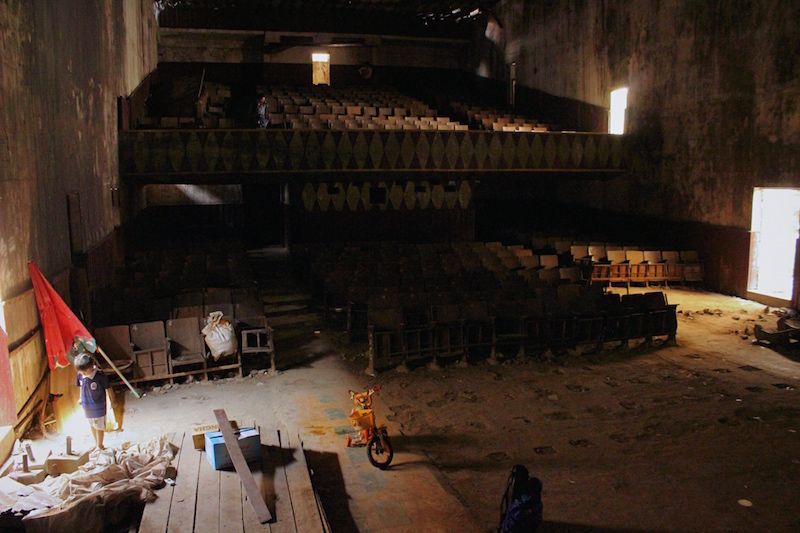Since last September, Jessica Austin has been crisscrossing the country in search of buildings that, half a century ago, were part of what made Cambodia magical: the country’s cinemas.
Unbeknownst to most people, they still stand in many towns and cities.

“As things changed and developed, those buildings weren’t renovated,” she said on Wednesday. “They are not cinemas anymore; they probably won’t be cinemas again.”
Ms. Austin’s photographs of those cinemas will go on exhibit on Friday night in Phnom Penh, and she will be on hand to give a “walking tour” through the buildings. Her photos reflect the glorious buildings they used to be, without hiding the fact that many of them are now derelict structures: grand but abandoned.
Ms. Austin, an American, became interested in Cambodia’s cinemas while specializing in Southeast Asian studies at the University of Hawaii at Manoa. She obtained a scholarship for Khmer language classes and visited the country several times.
“I read an article and a book that said that between the 1960s up to 1975, more than 400 movies were produced in Cambodia,” she said. “I was really shocked and I was sort of angry because I hadn’t run into anybody who had introduced me to that. People just weren’t talking about it.”
She had read a great many books and magazines about Southeast Asian movie houses, but Cambodia’s cinematic legacy was not mentioned, she said. “I felt like Cambodia is not given its place in [cinema] history: It has been ignored.”
One reason may be that people assume all traces of the movie industry are gone—films and buildings alike—due to the decades of war and conflict in Cambodia, Ms. Austin said.
Yet she has located old movie theaters across the country.
“There is the Moha Kompeing cinema in Kratie [City] that was built in the 1930s and used to be a cinema in the 1960s and 1970s,” she said. It later became a restaurant where traditional dance was performed during dinner or dance videos were projected with remaining equipment, she said. But it eventually shut down.
Eager to research both the buildings and the cinema industry at the time, Ms. Austin obtained a Fulbright Scholarship in the U.S. last September after securing a master’s degree in Southeast Asian studies.
Now, the 30-year-old researcher has been meeting Cambodian film directors and producers to learn about the film business in the 1960s and early 1970s while continuing her quest to locate old cinemas. “These cinemas might not exist in another two or three years, or even in one year,” she said.
In Battambang City, for instance, she found three cinemas: the Prasat Meas, the Battambang and the Sangke. One month after her visit, the Sangke was demolished, she said.
As part of her research, Ms. Austin photographed the old cinemas, attempting to capture not only the essence of the structures, but also the beauty they retained.
“I want to help the audience engage emotionally,” she said. “I want them to feel like ‘Oh, this is what it feels like to be in these cinemas,’ but also in the cinemas that used to be with the darks and shadows…the memory.”
What/When
Tour of the exhibition with Jessica Aus- tin, in English with Khmer translation as requested, on Friday, 5:30 to 6:30 p.m. Reception and presentation by Ms. Austin on ‘Social History of Cinema in Cambodia,’ in English, on July 14, 6:30 to 7:30 p.m. Exhibition runs through July 19
Where
Bophana Audiovisual Resource Center, 64 Street 200, Phnom Penh
Free admission